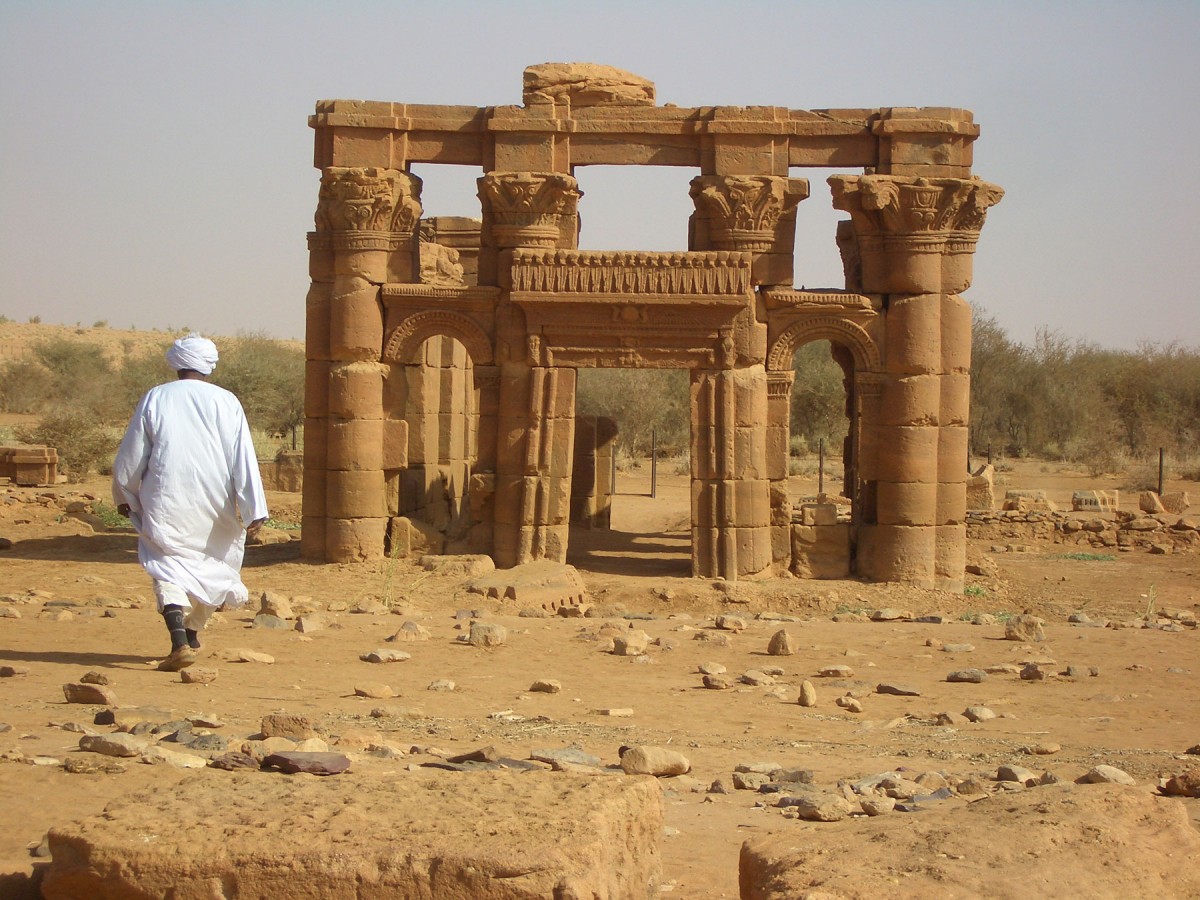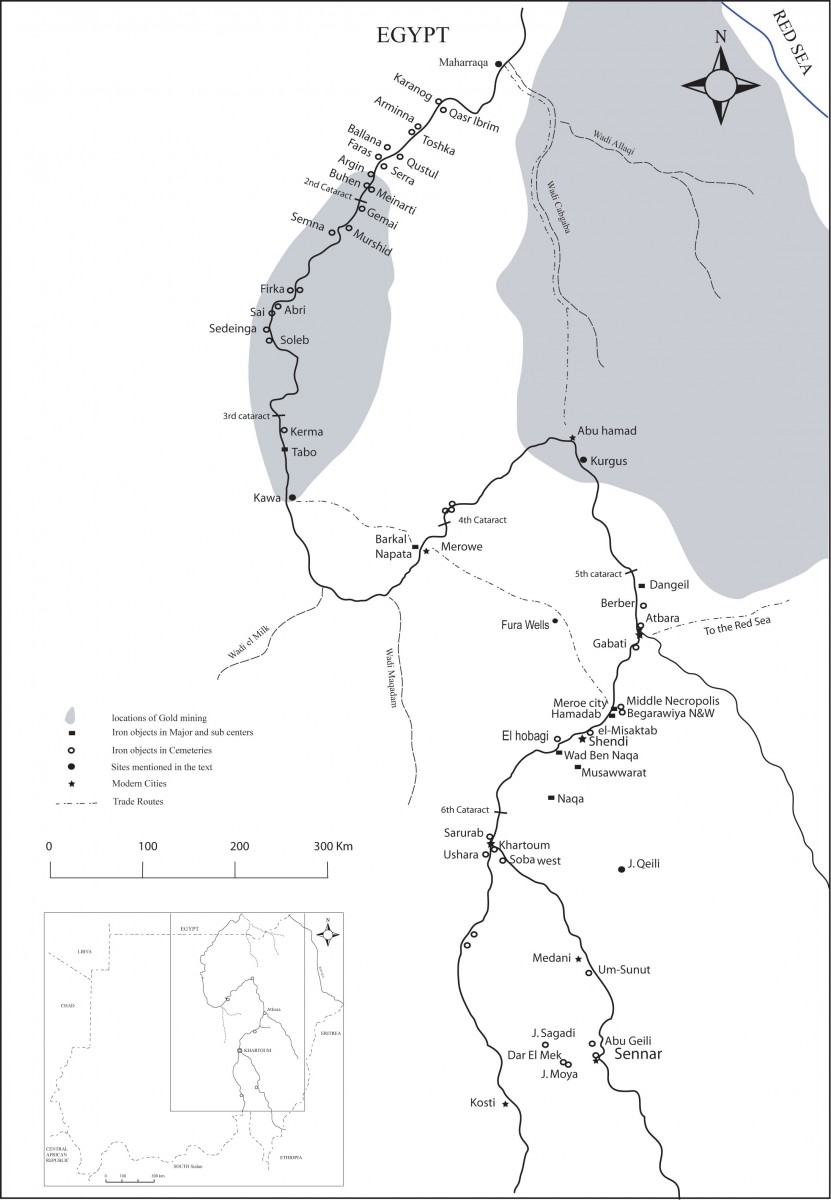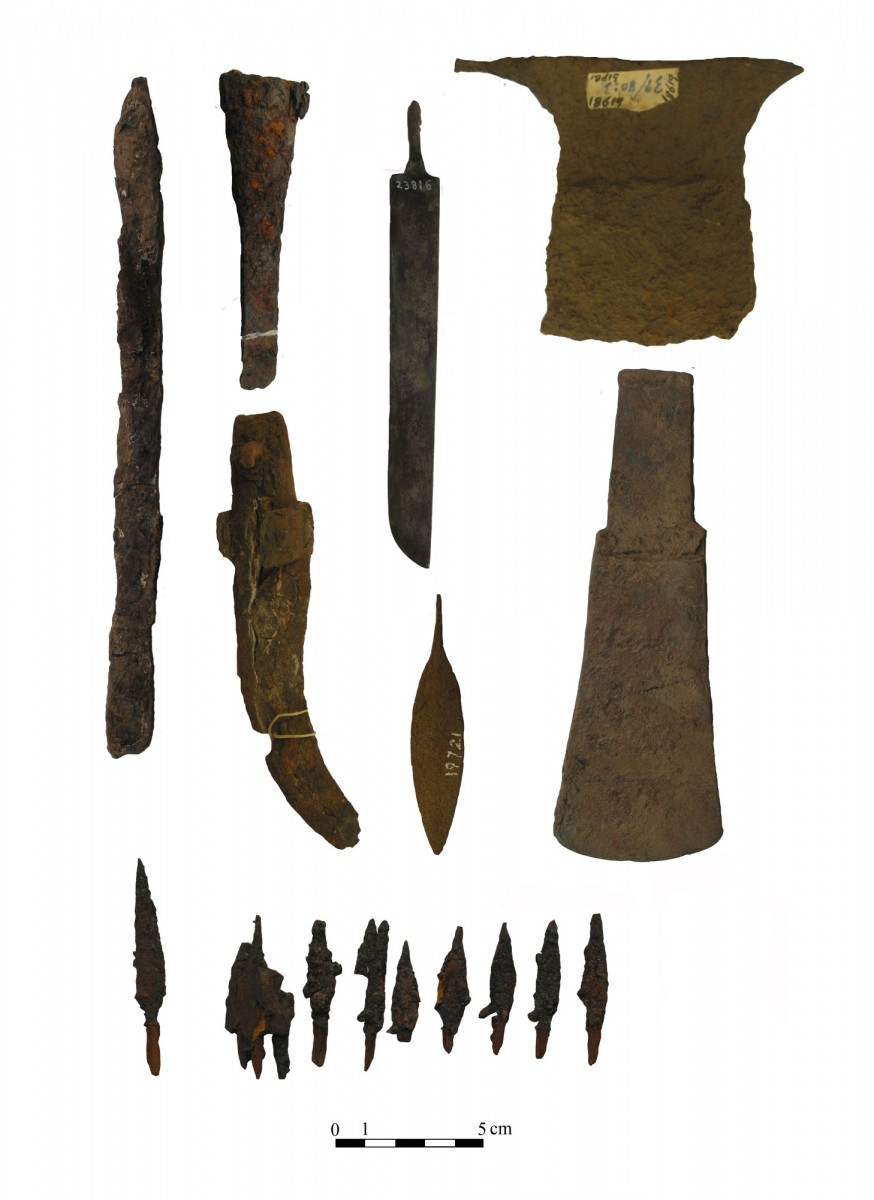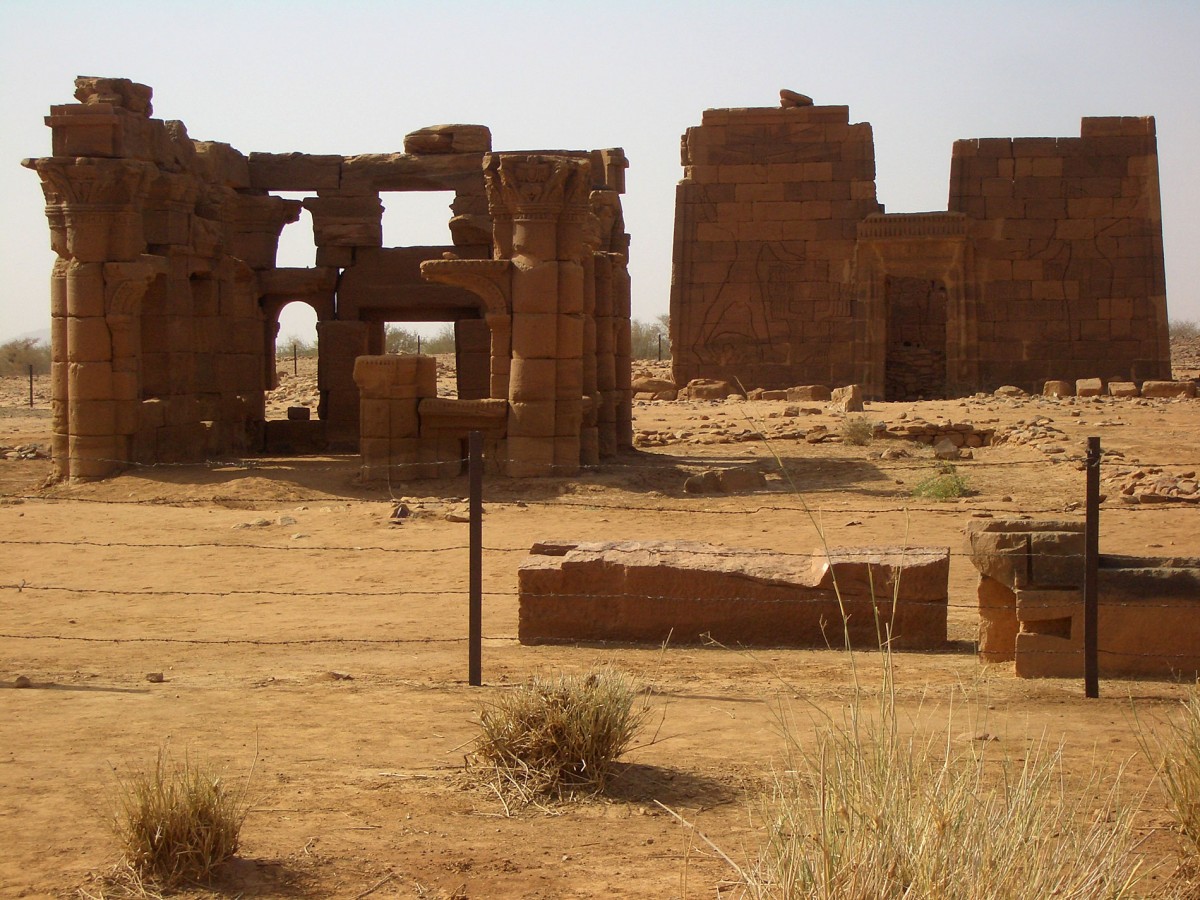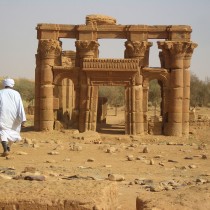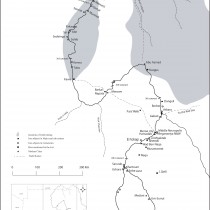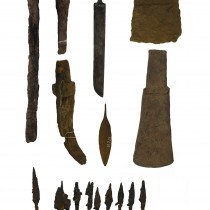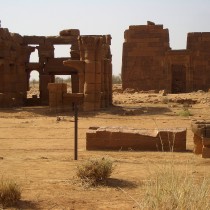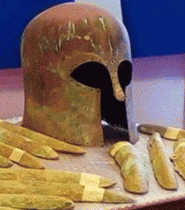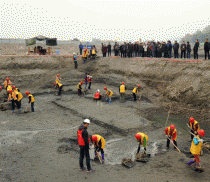The Meroitic state was located along the River Nile in Sudan. Meroe became the capital when the Kushite kings shifted the royal cemetery from the Napatan region to Meroe, connecting the southern and eastern peripheries with the north. The Napatan king Taharqo (690-664 BC) built the first Amun temple in Meroe. Other Amun temples were built during the Meroitic period in urban centers at Naga, el-Hassa and Dangeil. The Meroitic kings built small temples on the east bank and eastern hinterland and dedicated them to local gods especially the lion god Apedemak. The Meroitic state is recognized as a native culture influenced by Egyptian, Hellenistic and Roman ideas. The Second Cataract is the northern frontier of the state but the western, eastern and southern boundaries have not yet been identified historically or archaeologically. Any investigation of the interconnections between Meroe and its peripheries requires an examination of the Meroitic political economy and how local societies responded to Meroitic central powers through efficient use of local resources and exchange systems. As suggested by Yoffee (Yoffee 1995, 282), in order to understand the dynamics behind the interaction between the core and its periphery, it is essential to understand how Meroitic political power evolves, shapes and is shaped by the institutions of production, consumption and distribution, and how locals from peripheries defined, participated in, and often resisted the political ideologies of just and unjust social and economic arrangements. The extraction of resources from a periphery relies on either coercion or perceived and/or real benefits, or a combination of both. These mechanisms influence and are influenced by the productivity of the periphery and its interconnectedness with the political core. Political economy is also identified from the level of organization of political and economic relationships in a landscape represented by the distribution of monuments, roads, and settlements (Smith 2003). Types of goods exchanged between cores and peripheries comprise manufactured goods versus raw material and unprocessed agricultural products respectively. The center maximizes its profit and political power through monopolizing high-skill manufacture and the technology of mass production (Sherratt 1993, 4). Accordingly, the transmission of prestige goods of display served to signal and enhance status (Clark 1986, 82).
Scholars have constructed different models for the Meroitic political economy based on studies of the main urban centers. However, the lack of data outside the Meroitic core leaves these models untested from a regional perspective. This paper will examine how regional resources influenced Meroitic regional interconnections and significantly shaped the Meroitic political economy through an analysis of local production of iron and gold, and the distribution of exotic goods recovered from archaeological excavations. This arrangement reflects the core periphery interconnections and the extent to which negotiations of powers impacted the Meroitic political stability.
Historical background
Scholars have divided the Kushite culture into three phases, the Kerma period (2500-1500 BC), the Napatan period (8th to 4th century BC), and the Meroitic period (300 BC-350 AD). Before the rise of the Meroitic state in the south, the Napatan kings became major players in Near Eastern politics, vying for a hundred years for control of Syro-Palestine with the Neo-Assyrian Empire, which conquered Egypt but not Nubia in c. 657 BC. The dynamic Napatan mixture of Nubian and Egyptian culture, including the use of pyramids, continued from c. 300 BC to AD 400 during the Meroitic period (O’Connor 1993; Welsby 1996). The Kushites established sacred places for worshiping Egyptian and local gods along the river Nile from the north in Lower Nubia to the south as far as Wad Ban Naqa. Since the beginning of the Bronze Age around 3500 BC, the Nubian A-Group people engaged in long-distance trade to satisfy the Egyptian demands from the south such as ivory, ebony, incense and exotic animal skins (Hafsaas-Tsakos 2009, 59). The exchange system with the south is indicated by some pieces of Napatan jewelry from Kawa on the White Nile (Eisa 1994), and Napatan scarabs and amulets from Jebel Moya (Addison and Crawford 1949). The presence of pottery and bronze vessels in Sennar has been used to infer the existence of the Meroitic state far to the south (Welsby 1996) or at least the connections with the region through an exchange system. The six cataracts between central Sudan and southern Egypt made river transportation difficult between the north and the south. Therefore, the city of Meroe must have been connected with the north through routes across the desert (Edwards 2004, 155), as indicated by Meroitic buildings at Al-Meragh on the Wadi al-Mugaddam (Kendall 2001) and at El-Fura Wells in the eastern Bayuda desert (Crawford 1953) (map 1).
The construction of a regional network and the flow of Kushite resources between the north and the south developed into an exchange system both regionally and with the wider classical world. These relations entailed significant economic and cultural impacts and the recognition of the Meroitic power in the south. The continuing relationship with the north is recognized from artistic inspirations. The Egyptian arts and crafts were influenced by the Greeks already from the archaic period (ca. 800-500 BC). The influences from the Greco-Roman world are demonstrated in a large spectrum of arts and crafts from architecture to ceramic and glass vessels. Particularly in sculpture, the Meroites adopted many characteristic elements of Ptolemaic and Roman art (Al Sadig 2003). Such influences are also manifested in Meroitic architecture, as well as in art objects discovered in the royal city of Meroe, at Musawwarat, at Naga and elsewhere. Inspiration from Greek and Roman elements can be found in particular Meroitic types of column capitals, in the use of Roman arches, exemplified in the amalgamation of Egyptian and Meroitic elements in the Naqa Kiosk (fig. 1). Hellenistic influence is clearly illustrated in motifs from the so-called royal baths at Meroe that reflect the classical mythology (Hakim 1988, 3). Török (2002, 230-331) suggests, in his iconographic model, that the designers of the Hellenized Nubian images of the gods Amun and Apedemak were aware of the theology of the Hellenistic gods. He clarifies though that they were rather inspired by the Mediterranean iconography than by a theological orientation. The Hellenistic inspiration is better demonstrated in iconographic details from Naga, where the representations on the side walls of the Amun and Apedemak temples are a blending of the traditional imagery of Amun and Apedemak with new elements adopted from the iconography of Hellenistic gods, like Zues-Ammon and Sarapis.
The Meroitic political economy
Scholars have presented three different models to explain the Meroitic political economy that are based mostly on available archaeological data from urban centers. Adams (1976, 16-19) suggested the secular and sacred state model. He argues that the Meroitic polity in Lower Nubia may have been secular while that of the south was sacred. He based this idea on archaeological contrasts between the north and the south. Adams (1976, 16-19) recognized that fortresses and palaces were the symbols of power of the northern Meroitic state; while in the south the state power was represented by royal and priestly monuments. Adams suggested that exotic goods commonly found in settlements and graves show that individual elites rather than the state controlled the trade between Meroe and the Romans in the north.
Török (1997, 488-489) introduced the temple estate model. He studied mortuary inscriptions, temple graffiti and ostraca written in Meroitic and demotic (Egyptian) and their relationship to the Meroitic political economy. He suggested that the Meroites pursued the same strategy as the earlier Napatan political economy, where the territorial structure was associated with both the institution of Amun temples and royal residences. Moreover, the Meroites followed contemporary Egyptian economic administrative structures when they used the same Egyptian titles that were used in the north, strategus or “district commissioner” and “corn measurer”. According to the mortuary texts, the highest rank, viceroy (“king’s son”) in Lower Nubia had been confined to the members of the royal family until the 2nd-3rd centuries AD and only subsequently started to be assigned to Lower Nubian administrative elites as the Meroitic central authority weakened (Török 1997, 489-91). The political economy became more sophisticated when the Meroites began using a cursive script to write their own language in the 2nd century BC to support the developing economic administration. Along with representations of deities and symbols of royal authority, the Meroitic script was used on stamp seals that were impressed on the stoppers of vessels in order to indicate the origin of goods. Many of these seals were found in storerooms in the Natakamani and Amanitore palace at Napata (Vincentelli 1993, 116-141). Török also argues that the distribution of the settlements and defensive sites indicates that they functioned as caravan stations and/or military posts to protect the trade between Kush and Egypt (Török 1997, 399). He concludes from this evidence that large estates were administered by temples, which were directly controlled by the royal palaces.
Edwards (2004, 164) agrees with Török that the royal palaces and temples played a considerable role in the Meroitic state. Nevertheless, he argues that the model of the Egyptian temple estate suggested by Török is not supported archaeologically as the source of Meroitic political control. Edwards argues that the caches of seals from the palace of Natakamani and Amanitore were used for foodstuffs for the maintenance of the palace. The birth of the Meroitic state in a different environment than the north made its political structure very different from ancient Egypt (Edwards 2004, 168). The annual rainfall in the African Sahel led to more mobile populations in the large Meroitic territories to the south, which could not be regulated by controlling subsistence production (Edwards 2004; Haaland and Haaland 2009, 378). Instead, Edwards suggested that the source of Meroitic political power was the control over the exchange system in exotic goods rather than staples, or coercive control.
Export of locally obtained materials is indicated by goods that were found in magazines in Sanam, dated to the Napatan period (XXVth dynasty). This material consisted of raw elephant tusks, faience and alabaster objects, gemstones, and copper alloy (Griffith 1922). Raw materials recovered from storerooms in the palace of Amanishakheto (10-1 BC) at Wad-Ben-Naqa demonstrate that this trade continued into the Meroitic period. These storerooms contained storage jars, ivory, ebony, wooden blocks, and examples of other exotic goods that were processed and managed possibly for long distance trade (Vercoutter 1962), including gum Arabic (Bjørkelo 1983, 38). The areas from which these valuable materials were obtained by the Meroitic state for long distance trade and local exchange, however, remain unclear.
Local productions, such as gold and iron, have not been discussed comprehensively as a source of power in the Meroitic literature. The long history of gold export and the advanced iron technology, together with other commodities, were expected to reshape the region socio-politically and economically for the benefit of the Meroitic state in the first place. However, historical scenarios of the Greco-Roman presence in the North, tribal movements and the Axumite state to the east, together with the movements of commodities caused political instability in the region.
Gold
Vercoutter proposed two distinct sources of gold in Nubia. The first is the gold of Wawat, which is represented by the Wadi el-Allaqi and Wadi Gabgaba regions. The second source is from mines that were established close to the Nile valley at the Fourth Cataract in the geological base complex yielding gold ore (Vercoutter 1959, 133) (map1). The Fourth Cataract region was reported as a source of gold as early as the annals of Thutmosis III (c. 1450 B.C.) and gold is mentioned as coming from as far upstream as Abu Hamed by the time of the 20th dynasty (1200 BC). The significance of the area between the Fourth and the Fifth Cataracts is also highlighted by the Egyptian symbolic boundary inscriptions on the Hajar al-Merwa (a large quartz outcrop) at Kurgus near the Fifth Cataract. These monumental inscriptions might have indicated exclusive Egyptian access to sources of gold in the area during the new kingdom (Edwards 2004, 105). During the Meroitic period, and more precisely in the first century AD, Dangeil was probably established (Anderson and Ahmed 2010, 5) as an administrative center in the Fifth Cataract region to regulate the gold mines in hinterlands, east of the river Nile (Welsby 2005, 43).
The extraction of gold had always entailed negotiations of power and control over the sources. The gold of Kush was one of the main items exported as tribute to Egypt during the New Kingdom (c. 1500-1070 BC). The gold trade increased during the Meroitic period, possibly as a result of demand from Egypt during the Ptolemaic and Roman periods (4th c. BC-7th c. AD) (Vercoutter 1959, 133). It has been proven that gold is one of the essential and prestigious gifts given by elites to temples during the Kushite period. The king Taharqa dedicated a gift of about 110 kg of gold to the temple of Kawa. Beside the fact that gold was one of the main Meroitic exports to Ptolemaic Egypt (Rostovtzeff 1941, 381), it was also found in almost all of the pyramids in Jebel Barkal and at Meroe (Vercoutter 1959, 138). Nevertheless, archaeological evidence from the royal cemeteries of Kush led Arkell to argue that the quantity of gold produced declined during the Meroitic period due to an increase in autonomy and power of the Eastern Desert tribes (Arkell 1955, 170). However, negotiations of economic benefit took place and gold continued to play a significant role when the Meroites obtained gold through exchange systems with the same tribes and concentrated on mining gold near the river (Arkell 1955).
The establishment of the frontier at Maharraqa by the Ptolemaic and Roman rulers of Egypt was mainly aiming at securing access to the gold mines through the Wadi Allaqi that met the Nile Valley at precisely that point (Griffith 1937, 1). Furthermore, the relationship between Meroe, Egypt and the Mediterranean world was constructed ‒among other reasons‒ so as to protect the southern frontier and maintain the supply of the Meroitic gold for Egypt (Vercoutter 1959, 138). Historically, the Meroitic ambassadors mentioned by Diodorus Siculus in Egypt during the Ptolemaic period (332-30 BC) suggest that exchange of gifts was practiced between the elites of Meroe and Egypt by at least the mid first century BC (Eide et al. 1996, 704ff). The Meroitic rulers were likely to have continued long-distance trade and gift exchange with Roman rulers (30 BC-395 AD) to maintain the Meroitic political power (Edwards 2004, 167) to some extent through access to Roman luxury goods. These goods are demonstrated materially by limited imported commodities found in Meroitic elite burials, in urban centers and at the modern city of Sennar (Addison 1935).
Iron and power
Extracted iron cores and the technology used for iron production require skilled labor and efforts. Usually the technology becomes important to societies and is used as a source of power when durable and suitable prestige objects are produced for local consumption and long distance trade (Delmonte 1985, 238). The term Iron Age can be used for the ancient cultures of Sudan, at least for the period after the establishment of iron-working at Meroe: This takes place by the 5th century BC (Trigger 1969, 23-50), although it remains unclear whether this technology was a natural industrial evolution invented locally or was imported through cultural contact. In that context, it is essential to note that since the beginning of the first millennium BC the Kushites were in contact with their neighbors, be they Assyrians (Dalley 1985 in Edwards 2004), Greeks, or the Hellenistic and Roman rulers of Egypt.
Haaland and Haaland argue for a symbolic link between royalty, iron and the local god Apedemak during the Meroitic period (fig. 2). Their argument is based on the assumption that temple M6 is constructed on an iron slag heap. Although other Apedemak temples were intentionally elevated and built on platforms (Hakem 1988, 183), it is more likely that ritual activities in these temples were essentially tied to the negotiation of strategic resources such as “territory, social rank, crops, tribute and animal resources”; especially in the Meroe region where Apedemak depictions symbolize power and reinforce social order in the region. Images of the kings holding a weapon in the act of smiting the enemies reflect sacred stories and signify religious and royal authorities.
Iron technology was founded in the Meroe region in the south for production of a new valuable product for prestige and later it was also used for exchange goods. The earliest valuable iron objects during the Kushite period were found in Taharqa’s pyramid and are dated to the 7th century BC (Dunham 1955, 12). Nevertheless, the iron industry started at Meroe city by the 5th century BC (Trigger 1969, 23-50) and continued to the post Meroitic period (Humphris 2014, 124). Elites controlled the iron-working industry as indicated by concentrations of slag heaps in Meroitic urban centers at Meroe, Hamadab, el-Hassa and Muwais. This monopole suggests that the state prohibited private ironworking in rural areas and monopolized both its production and distribution (Mohamed 2005). Iron objects have been unearthed only from within the Meroitic territory and no evidence has been found so far to indicate that iron was one of the items exported to the Mediterranean markets or to the Red Sea. Therefore, I suggest that iron production served essentially to maintain the primacy and social hierarchy of the Meroitic elites through territorial exchange systems and to extract local resources. This assumption is supported by the vast distribution of iron objects along the river Nile from the north to the south (map 1). It is also expected that the flourishing regional exchange system, including the flow of newly invented iron weapons to marginal areas, must have developed local autonomies and regional factions which led to tribal movements and aggressions.
It is essential at this point to note that Meroe produced substantial amount of iron objects that had significant impact on the Meroitic power and its contact with the external world. Scholars have estimated the scale of iron production during the Meroitic period.
Trigger (1969) carried out a statistical study based on iron objects found exclusively in the royal cemeteries of Kush.Rehren studied chemical components of core, slag and produced iron objects and estimated the iron production at 5 tons a year (Rehern 2001, 107). He also proved that the Meroites were able to produce durable objects (steel) (Rehern 1996, 23).The author (2005) measured a total of 1461 physical iron objects that were recovered from excavated Meroitic sites and presented an estimate of a total amount of 101.5 kilograms of physical iron production. Considering undiscovered and deteriorated iron objects in the field, the amount of iron produced must have been much greater than the amount presented, but not as much as suggested by Rehren. However, the study marks a significant local evolution in weapon production. The weapons manufactured, mainly arrowheads, represent 49.5% of the total iron objects by number, not by weight (fig. 3). Therefore, iron weapons must have played a primal role in regional warfare and the conflict with the Egyptian Roman in the north. However, the remaining objects show a variety of use types represented by ornaments, homestead and work tools, agricultural tools and a considerable amount of objects of unknown function. The variety of iron objects reflects an effort to maximize the potential of iron manufacturing under the given sociopolitical, economic and cultural environment.
The Meroitic army
Unfortunately we know very little about the Meroitic army, whether it was a professional force or a peasant militia raised in times of need. Archaeological contexts have failed to provide evidence to assume the identity of individuals buried in tombs and associated with iron weapons, namely whether or not they were members of an army or soldiers (Welsby 1996, 39-41). Nevertheless, Welsby assumed that urban and military defence structures may have been constructed by the army (Welsby 2005). However, it is also possible that peasant militias established the forts and caravansaries that were built to protect trade caravans when necessary.
Iron weapons were not mentioned as part of the Kushite armament in early historical texts. Herodotus in the fifth century BC described their weapons as consisting of long bows made from palm trees, short arrows made of cane and tipped with sharp stones instead of iron. The points of their javelins were sharpened antelope horns, and they also carried knotted clubs (Eide et al. 1996, 314). Strabo also described the Meroitic troop that faced the Roman invasion in 24 BC and stated that they were badly armed. Most soldiers were equipped with bows and arrows and shields, and some also had pikes or swords (Welsby 1996, 41). Although weapons were depicted in different contexts such as walls of pyramid chapels, the Sun temple at Musawwarat, and the Abu Geili trophy of king Shorakaror (Mohamed 2005), they can only demonstrate symbols of power, while the material could be iron, stone or copper. Nevertheless, the study conducted by the author (Mohamed 2005) challenged the historical records and made obvious that Meroe manufactured different types of iron objects, the majority of which were weapons that most likely used in warfare to defend the Meroitic sovereignty, frontiers and to maintain political stability from local and external threats.
Warfare
Nubians were known as highly skilled archers who fought as mercenaries in the Egyptian armies. Herodotus described the first contact with the Meroites when they fought beside the Persians against the Greeks in 480 BC (Al Sadig 2003, 112). The regional exchange system must have equipped local populations with iron weapons and thus empowered elites in marginal areas. At the same time this system also caused unrest on the frontiers of the Meroitic state and destabilized the central power. This scenario is attested by regional warfare and external threats that contributed significantly to the weakening and the decline of the Meroitic state in the fourth century AD.
Regional warfare is known from different resources. Early examples of missions of the Kushite army against local tribes are known from Irik-Amanote’s inscription from Kawa (431-405 BC) stating that his army fought the Rhrhs tribes. Harsiyotef (404-369 BC) and Nastasen (335-315 BC) also recorded their campaigns against a variety of rebel groups where Harsiyotef’s forces included bowmen and cavalry. The Nuba/Noba described in the Greek sources and recorded in the 3rd century BC through the 2nd century AD, settled in the area on the west bank and extended from Meroe to the north as far as the Bayuda region (Török 1997, 482). The violent conflicts between these tribes and the central state at Meroe are represented by triumphal representations from Napata, Meroe and Gebel Geili (Török 1989a & Török 1997). The Noba took over some of the Meroitic towns in the east (Edwards 2004, 183), attacked local tribes and created unrest between Axum and Meroe that led to an Axumite invasion against Meroe (Burstein 1984). Despite the negotiations between the two polities and warnings given by the Axumite King Ezana, Meroe did not take action to defend its territory, most likely due to internal political problems and the absence of an official army. This explanation is supported by texts left by the Axumite king Ezana, whose army faced no resistance in the region during his invasion from Ethiopia in the middle of the 4th century AD (Burstein 1984).
The contact with Rome
During the early first century BC, inscriptions from Philae suggest political implications between the Roman Empire and the Meroitic state. The Greek inscription of the first Roman governor of Egypt Carnelius Gallus entails his friendly relations towards the Meroitic ruler (Eide et al. 1996, 689). Despite this friendly relationship and the Meroitic participation in the cults of Philae during the Roman era, a confrontation occurred between the two polities.
In 25 BC, armed Meroites attacked Philae, Syene and Elephantine, and looted and carried off prisoners. Török assumed that Meroe directed this conflict only against the Roman vassalage established in the north of the Meroitic fringes. However, the reaction of the Meroitic political center took place at the same time, when an army was raised most likely especially to defend the Meroitic territory, under the command of king Teriteqas who left Meroe to support the rebels at Triacontaschoenus. The Meroitic army met the Roman army at Dakka and the conflict ended with victory for the latter. Petronius established a garrison at Qasr Ibrim to demarcate the southern Roman frontier (Török 1997, 452). In fact, the negotiations between the two polities started when Petronius rejected the peace offer by the Meroitic Queen Amanirenas. However, the unrest between the two polities ended with a peace agreement conducted on the Greek island of Samos between a Meroitic delegation and the Roman Emperor himself.
Conclusion
There is clear evidence of exchange systems and long-distance trade that was regulated by forts and caravansaries to maintain movements of artifacts regionally and with the Mediterranean world during the Kushite period. The exchange systems underscore relationships as key factors through which political economy and the exercise of powers continued to be negotiated during the Kushite periods, especially for the Meroitic state. Gold and iron played significant roles in regional interconnection and gold in particular in the contact with the external world. Gold was frequently tied to the negotiations of strategic resources that were produced in peripheries and controlled by elites. The production was used to access luxury goods through long distance trade with the North and to satisfy the demands of local elites. The relationship with the Greco-Roman counterpart was not limited simply to exchange of commodities but also entailed significant influence in the arts as well as negotiations of power, even occasional aggression.
The restriction that iron should be produced exclusively in elite urban centers provides potentially convincing evidence that iron was used as a valuable and strategic subject to negotiate political and economic powers as well as to enhance social stratifications. The development of an iron industry suggests that iron production increased and was used not only for producing iron weapons but also for producing objects used for different daily activities such as homesteading, agriculture etc. The Meroitic state may have reorganized the existed economic strategy through investing largely in internal exchange systems when iron production increased and the Romans dominated the Ethiopian Red Sea coast for commercial purposes and direct access to the African luxury goods (Török 1997, 464). This change in economic strategy is also supported by the vast distribution of local iron artefacts versus imported objects found within the Meroitic territory. The vast distribution of iron objects challenges the classic historians and provides evidence of use of iron weapons during the first century AD and most likely used during the conflict with Rome. It is essential to note that the vast distribution of iron weapons throughout the Meroitic peripheries must have encouraged local autonomy and led to factions in certain places. Despite this technological development, archaeologists have not been able to present clear evidence that Meroe produced an official army that could be used to reconcile tribes within the territory, against the Roman Egypt, or even to resist the Axumite invasion from the east by the middle of the fourth century.
Mohamed Farouq Abdelrahman
PhD candidate at the University California Santa Barbara
